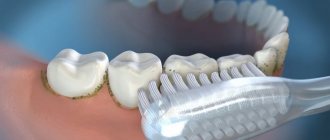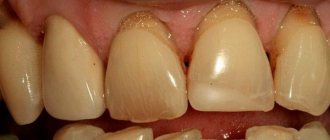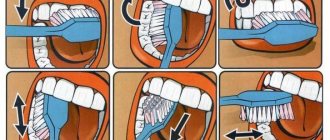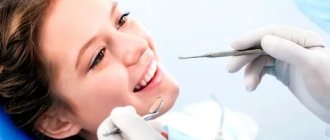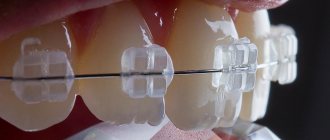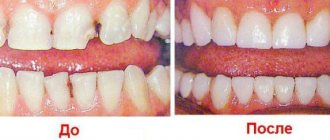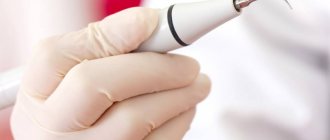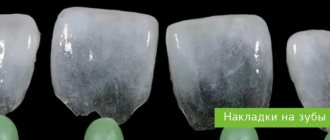Tartar not only disrupts the aesthetics of a smile, but leads to gum disease, bad breath, the development of dental caries and, in advanced cases, tooth loss.
Regular teeth cleaning using ultrasound removes hard plaque from the surface of the teeth and from shallow periodontal pockets (maximum up to 5 mm), the procedure is carried out using a special device - a dental scaler (scaler). The device can be built into a dental unit or stand-alone.
An ultrasonic scaler consists of a control unit and vibration generation unit, a handpiece, removable (replaceable) attachments and a control pedal. The device is equipped with a liquid supply system. During operation, the device creates ultrasonic vibrations with a frequency of 25-30 kHz, which are transmitted to the tip nozzle.
Physical principle of operation: an ultrasonic wave is transmitted from the tip to the scaler nozzle, which in turn transfers it to dental plaque. Under its influence, deposits are destroyed from the inside. To prevent damage to tooth enamel, the dentist moves the attachment strictly along the surface of the tooth. The simultaneous supply of water to the zone of ultrasound influence provokes the effect of cavitation, the formation of micro-bubbles in the volume, which accelerate the process of destruction of tartar. At the same time, water or a medicinal solution helps wash away dental plaque destroyed by ultrasound from the treatment area.
Operating principle of ultrasonic cleaning
Tartar removal using ultrasound is based on the destructive effect of high-frequency waves on hard deposits. The procedure is carried out using a special attachment - a scaler.
The directed action of the waves explains the fact that the stone practically crumbles before our eyes, turning into powder. The simultaneous supply of water washes away plaque and cools the tooth, relieving discomfort.
The main advantage of the method is that using a scaler you can clean subgingival pockets. Laser and chemical cleaning do not provide this opportunity.
Another important point is the bactericidal effect. Under the influence of ultrasonic waves, pathogenic bacteria that cause dental damage and oral diseases die.
Caring for your teeth after ultrasonic cleaning
After the procedure, especially if a lot of plaque has been removed, there is a slightly increased sensitivity of the teeth to temperature and chemical irritants, so for 24 hours after cleaning, patients are advised to refrain from eating excessively hot, cold, sour and salty foods. It is advisable to follow a “white diet” for a couple of days, as after teeth whitening, to exclude strongly coloring foods from the diet (red wine, coffee, black tea, beets, some bright fruits and juices from them) so that the cleaned enamel does not absorb food dyes, and on the contrary, enrich it with solid and fiber-containing products that will prevent the appearance of plaque and stones (fruits, vegetables, nuts, etc.).
If sensitivity is severe, it is recommended to replace your regular toothbrush with a soft-bristled brush for several days and purchase toothpaste that reduces sensitivity.
After each meal, you need to rinse your mouth with clean water - this rule must be observed not only after ultrasonic cleaning, but also constantly.
On the first day or two, it is also recommended to brush your teeth after every meal.
Is ultrasonic teeth cleaning harmful?
Hygienic teeth cleaning with ultrasound does not have a negative effect on the human body and is recognized by experts as absolutely harmless. The only thing is that there are a number of restrictions, in the presence of which it is not recommended.
Ultrasonic cleaning is a mandatory procedure before prosthetics, installation of braces and implants. It is also recommended that those suffering from periodontitis visit their dentist or hygienist twice a year.
Signs of tartar:
- visible plaque on the enamel - primarily appears on the inner surface of the teeth, as well as on the root part;
- bad breath in the absence of diseased teeth is explained by the vital activity of pathogenic bacteria;
- inflammation, bleeding, swelling of the gums;
- the appearance of pronounced gingival pockets.
Important. If you notice these signs, you should immediately consult a doctor.
The most frequently asked questions from patients about the procedure
How painful is it?
(click to expand) Ultrasound teeth cleaning is a painless procedure, but it may be accompanied by minor discomfort in the presence of subgingival dental deposits - to remove them you need to slightly disturb the gums. Patients with increased sensitivity of the enamel may also complain of pain. In such cases, the doctor will perform cleaning with maximum comfort for the patient, using local anesthesia.
Is ultrasonic cleaning whitening? (click to expand) No, whitening is a completely different procedure, it is carried out using special whitening compounds that are applied to the tooth. A slight lightening of the enamel is due to the fact that after ultrasonic cleaning, the surface of the teeth is polished; sometimes the difference in color is clearly visible.
Is it true that plaque appears on teeth faster after ultrasonic cleaning? (click to expand) No, that's not true. On the contrary, after ultrasonic cleaning followed by polishing the enamel, plaque appears more slowly. Maintaining oral hygiene helps prevent its occurrence: responsible brushing of teeth at least 2 times a day, rinsing the mouth after meals, choosing the right toothpaste. Smoking, excessive consumption of tea and coffee, and metabolic disorders in the body contribute to the rapid appearance of plaque.
Can cleaning damage the enamel? (click to expand) If the procedure is carried out correctly, damage to tooth enamel is excluded. After cleaning, weak and thin enamel is additionally strengthened with remineralizing gels, the enamel is actively saturated with microelements, and it becomes stronger.
What should I do if I have an acute inflammatory process on my gums? (click to expand) Acute inflammation of the gums, accompanied by bleeding, in most cases is a contraindication to ultrasonic teeth cleaning until acute symptoms are relieved. We offer our patients tartar removal simultaneously with gum treatment using the Vector device. This is a specially designed ultrasonic scaler that is equipped with a unique Paro tip that creates special ultrasonic vibrations. The device allows for deeper treatment of periodontal pockets if the patient is diagnosed with periodontitis; Simultaneously with the removal of dental plaque, the enamel is polished with a special polishing liquid. After its use, supragingival and subgingival deposits, inflammation of soft tissues and bleeding are completely eliminated, bad breath disappears, and oral health is restored.
Is the procedure allowed during pregnancy? (click to expand) Ultrasonic teeth cleaning is not only allowed for pregnant women, but is also recommended for mandatory use. This is explained by the frequent occurrence of problems with teeth and gums in pregnant women due to hormonal changes and the need to sanitize the oral cavity before childbirth. The procedure is completely safe for the health of the expectant mother and her baby, but you still need to consult a gynecologist before performing it.
How often should you resort to ultrasonic teeth cleaning? (click to expand) We recommend that our patients have their teeth cleaned with ultrasound every 6-12 months; sometimes, if there is an increased tendency to form plaque, cleaning is done more often. The best solution is to carry out a comprehensive oral hygiene cleaning, which helps maintain oral health and fresh breath.
Ultrasonic teeth cleaning helps prevent the development of many dental diseases, so do not neglect this procedure.
Pros and cons of ultrasonic tartar removal
The ultrasonic tartar removal procedure has significant advantages over other methods of teeth cleaning. It is less traumatic than mechanical removal of deposits, and more functional than chemical and laser treatments. After cleaning, the enamel acquires a natural color, which makes it possible to choose an implant or filling as close as possible to the desired shade.
Advantages
In most cases, dentists prefer the ultrasound method. In one procedure, the doctor can completely treat all teeth, including subgingival pockets, which guarantees the most complete removal of hard deposits.
The main advantages of the procedure include:
- high-quality treatment of the tooth surface, including fissures, without damaging the enamel;
- removal of solid deposits even from the most inaccessible places;
- painlessness of the procedure;
- treatment of periodontal pockets;
- bactericidal effect – complete destruction of pathogenic microflora.
It also makes sense to talk about the prevention of caries, periodontitis, inflammatory diseases of the gums and teeth, since well-polished enamel prevents the rapid settling of deposits.
Important. The procedure does not cause allergic reactions, which is especially important for asthmatics and allergy sufferers.
Flaws
Perhaps the only drawback of the procedure is slight pain on sensitive teeth. In such cases, the doctor uses local anesthesia in the form of a gel. The disadvantages include the presence of contraindications for the patient.
Advantages of ultrasonic dental plaque removal
Ultrasound removal of plaque and tartar has a number of advantages. First of all, it is worth noting the high efficiency and versatility of the technology: it is ideal for removing pigmented plaque and perfectly removes stone from the most inaccessible areas of the oral cavity, even from deep periodontal pockets.
Removing plaque and tartar with ultrasound helps destroy pathogenic microflora in the oral cavity and, what is especially important, cleans periodontal pockets from pathogenic bacteria.
A clear advantage of removing dental plaque with ultrasound is the affordable cost of the procedure. On average, you will have to pay 4-5 thousand rubles for removing plaque and tartar, polishing and remineralizing teeth.
How to clean teeth with ultrasound: stages
Your very first step is to go to the dentist. The doctor will do the rest.
The procedure is carried out in several stages:
- applying an anesthetic gel to the surface of the teeth - if necessary;
- directly removing tartar from enamel;
- treatment of subgingival pockets;
- grinding using special pastes;
- polishing - at the request of the patient.
The stone is removed under the action of a scaler with the simultaneous supply of a stream of water.
Modern techniques involve the use of the Air-Flow method together with ultrasound. After hard deposits have been removed, it is possible to treat the teeth with a water-abrasive mixture under pressure. Microscopic soda crystals penetrate even the interdental spaces, clean hard-to-reach places well, and polish the enamel.
The combined use of ultrasound and Air-Flow ultimately gives excellent results. The surface of the teeth becomes smooth, deposits disappear, the teeth look well-groomed, and the smile becomes beautiful.
Important. You should not uncontrollably (and also under control) rub your teeth with soda powder. In this case, you are guaranteed to have thinning enamel, but the deposits will remain in place.
Why does tartar appear?
The cause of tartar formation in children and adults, in most cases, is poor hygiene or an unhealthy environment in the oral cavity. After eating, crushed food debris mixes with saliva and bacteria to form plaque on the surface of the teeth. It can be easily removed with toothbrushes or floss if done in a timely manner. If teeth cleaning is not carried out regularly, and the composition of our saliva is disturbed, then over time the usual yellow plaque hardens, turning into mineralized deposits, which can only be removed with the help of special devices for removing tartar.
Depending on the location in relation to the gum, supragingival and subgingival tartar are distinguished. Supragingival is easy to detect on your own during examination. It is a yellow or brown clay-like consistency that can be removed with a special tool. The main places for the formation of such a stone are in the area of active salivation. Subgingival calculus has a hard base that is dark brown or greenish-black in color. It can only be detected by gum recession or with the help of a probe. The formation of subgingival deposits is possible on any tooth, regardless of the distance of the salivary glands.
Is it painful to brush your teeth with ultrasound?
The procedure is considered painless, but may cause some discomfort if the enamel is sensitive. If the patient has a high pain threshold, he may well do without anesthesia. But in most cases, the dentist applies a special gel to the surface of the teeth. Also, applying water to the tooth when exposed to a scaler helps reduce pain.
Stone removal with 20% discount
Moscow
Will my teeth hurt after brushing?
No, no and NO. On the contrary, all patients, without exception, note extraordinary freshness in their mouth after the procedure. If you can say – even a feeling of lightness. The removed deposits do not put pressure on the enamel, and the feeling of tension in the teeth disappears.
When exposed to a scaler and a water-abrasive mixture under pressure, the gums are massaged. Blood circulation is normalized in the soft tissues, which also provides noticeable comfort in the mouth.
In general, ultrasonic cleaning is great. Having done it at least once, you will come to the dentist once every six months as required. Please note, come with pleasure.
Methodology
Assuming that the medical history has been collected and the patient has been given all the necessary explanations, ultrasonic teeth cleaning is carried out in the following sequence:
- The patient sits in a chair, the doctor examines the oral cavity and determines the amount of work to be done. In case of increased tooth sensitivity, local anesthesia is performed, but usually the procedure is carried out without additional anesthesia;
- The doctor installs a mouth opener - a special device that helps the patient hold his mouth open for a long time (the cleaning procedure lasts about 30 minutes on average). Thanks to the mouth retractor, the dentist gets full and unobstructed access to the surface of the teeth;
- Dental plaque is removed with an ultrasonic scaler. The water that is supplied to the tooth surface during operation of the device, along with particles of tartar and saliva, is removed from the oral cavity using a saliva ejector. First, the visible part of the crowns is cleaned of soft deposits, then tartar along the gum border is removed, and finally, periodontal pockets are curetted;
- Upon completion of the plaque removal procedure, the doctor polishes the surface of the teeth with a special polishing paste, this makes the enamel smooth and prevents plaque from re-attaching;
- The next stage (performed if necessary) is the treatment of teeth with a fluoride-containing gel, which strengthens the enamel and restores its structure. The composition is also able to protect the enamel from external influences and reduce tooth sensitivity;
- If there is inflammation on the gums, they are treated with anti-inflammatory drugs. The patient continues to care for his gums at home using products recommended by the dentist: this can be rinsing or treating the gums with gels and solutions purchased at the pharmacy.
Contraindications
A significant drawback of the procedure is the presence of contraindications. The doctor will definitely ask if you have any diseases or orthopedic structures, the presence of which implies a refusal to carry out cleaning.
Contraindications in this case include:
- acute bronchitis, asthma;
- diseases of the heart and blood vessels, installed pacemaker;
- infectious diseases, including ARVI;
- first trimester of pregnancy;
- presence of implants, bridges, braces;
- in a separate line – epilepsy, hepatitis, HIV.
It is also not recommended to perform the procedure on children's baby teeth.
Prevention of tartar
Tartar appears after the formation of yellow plaque on the teeth, so various ways to combat it will be prevention. The main thing here is safety! Toothpaste can be used as an affordable preventative against tartar. Fluoride-containing and whitening toothpastes are suitable. The former have relatively safe abrasiveness, due to which it is possible to effectively remove plaque. But due to the possibility of damage to the enamel, this product cannot be used constantly. As an alternative, you can buy an ultrasonic brush, which removes plaque quite effectively, which means it is a good prevention of tartar. Fluoride-containing toothpastes, in turn, are biologically active and can increase the resistance of teeth to caries, which is very important if they are prone to the formation of tartar. Using ultrasonic brushes and the best irrigators can also help combat simple deposits. The correct mouth rinse, which contains potassium citrate, will also prevent the formation of tartar.
Traditional medicine offers alternative methods of prevention in the fight against tartar. Raw hard fruits and vegetables such as black radishes, apples, carrots and radishes remove plaque naturally. A decrease in the formation of tartar has also been noted in people who consume lemon, birch sap and peas. Measures to remove tartar at home, such as the use of sand, soda and salt, are ineffective. They are strictly not recommended, as they can cause irreparable damage to tooth enamel. In general, removing tartar using folk remedies should be treated with great caution.
The use of pastes, special brushes and folk remedies to prevent the appearance of tartar will, of course, be beneficial. But only a dental hygienist can remove large and complex formations. Experts strongly recommend that absolutely everyone undergo professional hygienic cleaning twice a year. This is partly due to the fact that on average it takes about six months to form tartar. Regular visits to the hygienist’s office are the most reliable way to prevent not only dental plaque, but also diseases such as caries, gingivitis and periodontitis. Don't forget that dental treatment is much more expensive than the cost of professional oral hygiene from a hygienist.
Is it possible to brush teeth with ultrasound during pregnancy?
The best period for preventive cleaning is the second trimester of pregnancy. At this time, the child is already reliably protected by the placenta and is actively developing. Increased growth of the skeletal system provokes tooth decay in the mother, so we must try to protect ourselves as much as possible.
Ultrasonic cleaning with the addition of Air-Flow is considered by experts to be one of the best methods of prevention, as it allows you to sanitize the oral cavity as effectively as possible. The risk of caries is reduced, which allows you to simply save your teeth.
Before visiting a dentist, you must obtain permission from a gynecologist, since the decision is made individually, based on the woman’s condition.
Important. Ultrasound does not affect mother and child and does not cause allergies. The procedure is painless, and the mother feels excellent after the session.
Why is tartar dangerous?
The formation of dental plaque, and then tartar, is possible for various reasons: the involvement of only one side of the jaw, left or right, in chewing; dietary habits, in particular, eating only soft foods; salt imbalance in the body; using low-quality toothbrushes; crooked teeth; smoking. And some people have a congenital predisposition to the appearance of stones. In such cases, even regular care does not guarantee the safety of teeth.
Microbes, which make up 95% of plaque, form acid during their life processes, which, due to tartar, cannot be neutralized by the alkaline environment of the oral cavity. As a result, the enamel is gradually destroyed, and a favorable environment for the formation of caries is formed. Tartar also negatively affects the gums - located between the gum and the tooth, it becomes overgrown with new plaque, which in turn penetrates the gums and causes inflammation. This creates an unpleasant odor in the mouth, gingivitis develops, and with further neglect, periodontitis.
Photos before and after ultrasonic teeth cleaning
Author: Elena Kopylova Dentist-therapist, endodontist. Work experience more than 8 years. The information is for reference only. Before treatment, consultation with a doctor is necessary.
Prices
| Professional hygiene removal of plaque Air-Flow | 2500 rub. |
| Professional hygiene removal of stones with ultrasound | 2500 rub. |
| Carrying out the Air-Flow procedure in the area of one tooth | 150 rub. |
| Removal of dental plaque in the area of one tooth using ultrasound | 150 rub. |
| Deep fluoridation (one tooth) | 250 rub. |
| Determination of the hygiene index, KPU index | 200 rub |
| Comprehensive teeth cleaning (Air-Flow, ultrasound, polishing, fluoridation) | 8000 rub. |
| Professional whitening Zoom | 18000 rub. |
Recommendations after teeth cleaning to maintain and prolong the effect of the procedure
- Do not brush your teeth for the first 24 hours, but you can use dental floss and rinse your mouth for a minute with plain water;
- remove foods and drinks with coloring pigments from your diet;
- in the future, use a medium-hard toothbrush (it is advisable to choose it in tandem with your dentist);
- change your toothbrush about once a quarter;
- choose a paste taking into account the condition of your enamel and the characteristics of your teeth and gums (it is also better to do this in tandem with a doctor);
- Follow the rules of good daily oral hygiene.

